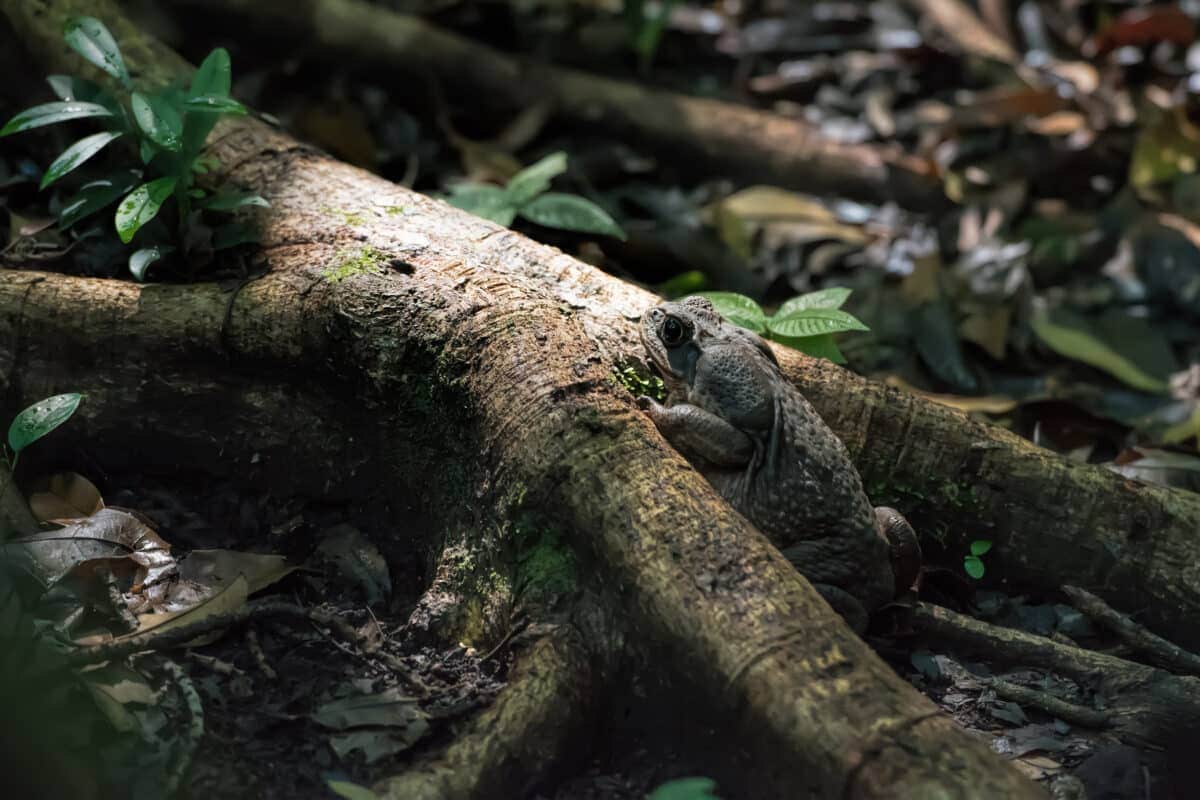Florida is home to several species of poisonous frogs, and it’s important to know how to identify them to avoid potential harm. While these frogs are small, their toxins can be deadly to both humans and pets. As their population grows, especially in the warmer months, it becomes crucial to understand which species pose the most danger and how to stay safe. Let’s explore the top toxic frogs found in Florida and how to protect yourself and your loved ones. It might be a good idea to keep your distance with this one!
The Infamous Cane Toad

The Cane Toad, also known as the Marine Toad, is one of the most dangerous amphibians in Florida. Native to Central and South America, it was introduced to Florida in the 1930s to control pests. Unfortunately, these toads release a highly toxic substance from their glands that can be deadly to pets and harmful to humans. By 2024, the Cane Toad has become one of the most invasive and harmful species in Florida.
Identifying the Cane Toad

Cane Toads are large, reaching up to 9 inches in length. They have a dry, bumpy skin that is brown or grayish with darker spots. One of their most noticeable features is their large parotoid glands located behind their eyes, which secrete a dangerous toxin. If you encounter a toad with these features, it’s best to steer clear and avoid contact with your skin.
The Deadly Cuban Tree Frog

Cuban Tree Frogs are another poisonous species causing concern in Florida. First spotted in the states in the early 1920s, these frogs can grow up to 6 inches and are known for their large, sticky pads that help them cling to surfaces. They produce a milky toxin from their skin that can cause severe irritation to the eyes and skin of humans. These frogs are often found around homes, making them a more immediate threat to residents.
Where to Spot Cuban Tree Frogs

These frogs are typically found in humid, tropical environments and are often seen near homes, pools, and gardens. They are nocturnal creatures, making them more active at night. Their coloration varies from green to brown or gray, allowing them to blend into the surroundings. Be cautious when gardening or working outside at night, as accidental contact with these frogs can lead to irritation.
The Toxic Green-and-Black Poison Dart Frog

The Green-and-Black Poison Dart Frog is not native to Florida but has been seen in certain areas due to the pet trade. These tiny frogs are just 1.5 to 2 inches long but pack a powerful punch with their skin toxins. Their bright green and black markings serve as a warning to predators, and they can cause serious harm if touched. Though they aren’t widespread in Florida, their presence is still something to be aware of.
Recognizing the Poison Dart Frog

These frogs are easy to spot due to their striking coloration. They are often found in humid, tropical areas, but because of their popularity as pets, some have escaped into the wild. If you come across a bright green and black frog, avoid touching it. Even though they aren’t commonly seen in Florida, it’s always a good idea to be cautious when handling any wild frog.
How Cane Toads Affect Pets

Cane Toads are particularly dangerous to pets, as the toxin they release can be fatal within minutes. Dogs are especially vulnerable because they often try to bite or lick these toads out of curiosity. Ingesting or even coming into contact with the toad’s toxins can cause vomiting, seizures, and, in severe cases, death. By the summer of 2024, reports of pet poisonings from Cane Toads in Florida had surged, making it crucial to monitor pets closely.
Signs Your Pet Has Been Poisoned

If your pet comes into contact with a toxic frog, you may notice drooling, vomiting, difficulty breathing, and disorientation. It’s important to rinse your pet’s mouth with water and seek immediate veterinary care if you suspect poisoning. Time is of the essence, as the toxins can act quickly. Preventing your pet from coming into contact with frogs is the best way to keep them safe.
Avoiding Contact with Poisonous Frogs

To reduce the risk of encountering toxic frogs, it’s essential to know their habitats. Poisonous frogs in Florida often live near water sources, gardens, and even in residential areas. Keeping your yard clean and free of standing water can help reduce frog populations. If you see a frog that looks suspicious, don’t attempt to handle it—call a wildlife expert for help.
What to Do If You Touch a Poisonous Frog

Accidentally touching a poisonous frog can happen while gardening or walking through Florida’s wetlands. If this occurs, it’s crucial to wash your hands immediately with soap and water. Avoid touching your face, especially your eyes, until you’ve thoroughly cleaned your hands. In severe cases where skin irritation occurs, seek medical attention to prevent further complications.
Preventing Poisonous Frogs from Entering Your Home

Frogs often seek shelter in cool, damp areas like basements or sheds. To prevent toxic frogs from entering your home, seal any gaps or cracks around doors and windows. Additionally, keeping your property well-lit at night can deter frogs from coming too close. Simple steps like these can help ensure that you and your family avoid any dangerous encounters.
Conclusion

Florida’s toxic frogs, especially the Cane Toad and Cuban Tree Frog, pose real risks to humans and pets alike. By understanding how to identify these frogs and taking precautions to avoid contact, you can protect yourself and your loved ones. Whether you’re out in nature or simply in your backyard, always stay vigilant and respect these dangerous amphibians from a distance. As always, please do let us know about your ‘toxic frog’ experience and how you handled it in the comments below!
- 2024 Guide to the Perfect Flowers for Each Zodiac Sign - June 25, 2025
- 10 Animals That Can Change Their Gender - June 23, 2025
- Top 10 Most Bizarre Creatures Found In The Amazon - June 23, 2025

